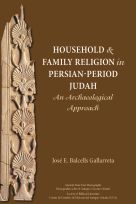Please use this identifier to cite or link to this item:
https://repositorio.uca.edu.ar/handle/123456789/8004| Título: | Household and family religion in persian-period Judah: an archaeological approach | Autor: | Balcells Gallarreta, José E. | Palabras clave: | LITERATURA RELIGIOSA; HISTORIA ANTIGUA; RELIGION; ARQUEOLOGIA; BIBLIA; JUDAISMO; RITOS; SOCIEDAD; IMPERIO PERSA; RITUALES; FAMILIA; TRADICION | Fecha de publicación: | 2017 | Editorial: | Society of Biblical Literature Pontificia Universidad Católica Argentina. Centro de Estudios de Historia de Antiguo Oriente |
Cita: | Balcells Gallarreta, J.E. Household and family religion in persian-period Judah : an archaeological approach [en línea]. Ancient Near East Monographs - Monografías sobre el Antiguo Cercano Oriente, Vol. 18. Atlanta: Society of Biblical Literature; Centro de Estudios de Historia del Antiguo Oriente, 2017. Disponible en: https://repositorio.uca.edu.ar/handle/123456789/8004 | Resumen: | Introducción: The Persian period biblical and nonbiblical textual traditions serve as valuable sources to study and understand the religion, or religions, of ancient Judah, especially early Judaism. Among their many valuable contributions, these texts as literary compositions reflect how ancient authors and editors recorded the religious practices and rituals in the Levant during the Persian period. As scholar of ancient religions Rainer Albertz notes, “[the Persian period was] one of the most productive eras in the history of Israelite religion.” Yet, while these texts narrate some of these details, there are still gaps in our understanding of how these ancient societies conceptualized the sacred and incorporated religious practices into daily life. Biblical texts typically provide the story from the viewpoint of what became the desired religious practices of the institutionalized or official religion at the Jerusalem temple through the writing of the elite. Given that the vast majority of ancient populations were illiterate, such written sources skew our knowledge towards the elite class of these societies. Individuals and social groups that were not part of this elite class are ignored or marginalized because of their illiteracy, socioeconomic class, location, and possible language barriers. These included women, widows, the poor, et cetera. So while textual information is useful for understanding household and family religious practices and rituals in the Levant during the Persian period, we cannot view these sources as normative as they leave common households and families out of the scholarly picture and overlook the material culture related to ritual and religion. Thus, household archaeology holds much promise in the study of family rituals and religion. | URI: | https://repositorio.uca.edu.ar/handle/123456789/8004 | ISBN: | 978-1628371789 | Disciplina: | HISTORIA | Derechos: | Acceso Abierto | Fuente: | Balcells Gallarreta, J.E. Household and family religion in persian-period Judah : an archaeological approach. Atlanta: Society of Biblical Literature; Centro de Estudios de Historia del Antiguo Oriente, 2017 Ancient Near East Monographs -Monografías sobre el Antiguo Cercano Oriente. 2017, 18 |
| Appears in Collections: | Series monográficas |
Files in This Item:
| File | Description | Size | Format | |
|---|---|---|---|---|
| household-family-religion-period-judah.pdf | 3,86 MB | Adobe PDF |  View/Open |
Page view(s)
205
checked on Apr 30, 2024
Download(s)
237
checked on Apr 30, 2024
Google ScholarTM
Check
Altmetric
This item is licensed under a Creative Commons License

